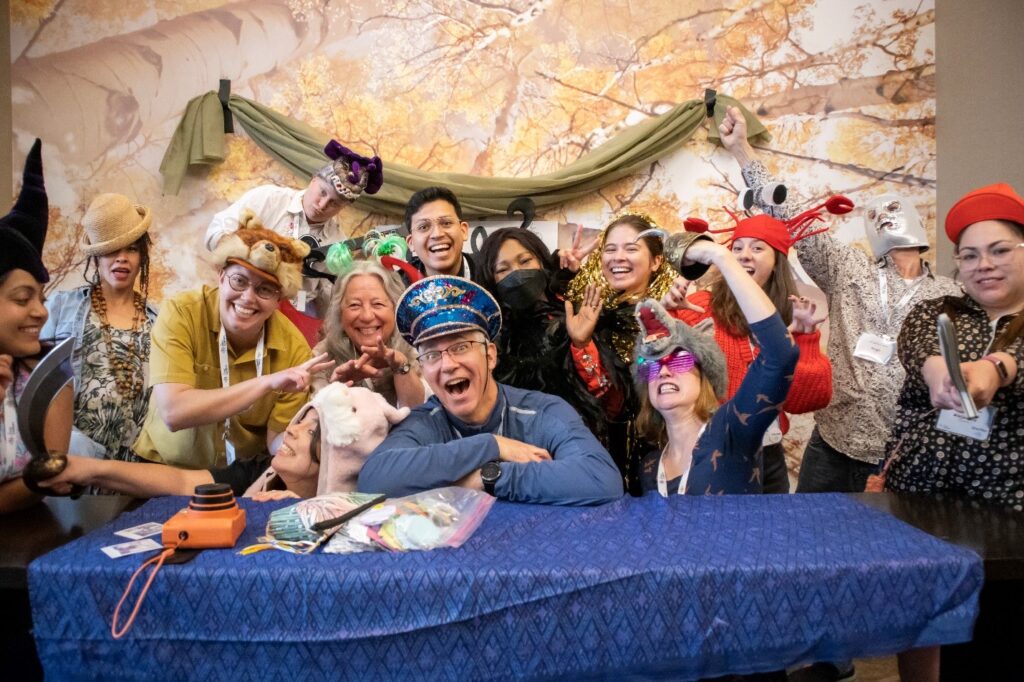“Don’t take life too seriously. You’ll never make it out alive.” I’ve had my rendition of Elbert Hubbard’s infamous quote written on a blue Post-it and stuck to my computer monitor for the last month as the Canopy team moved into its final lap of planning and executing the 2024 Canopy Summit: Catalyzing Culture Change. It was my first true venture into event planning and this Summit was the first we had hosted in person since 2018.
Though we’re elevated as “experts in collaboration,” we, too, fumble our way forward when doing something new as a collective. When we found ourselves along a bumpy planning path, it was easy to look for frequently recommended tools to bolster our processes. As we come to a close to the Summit and get ready for an After Action Review, I find myself reflecting on additional tools that helped our team to the finish line.
Three of the tools I found most helpful were the RACI, our own Community Learning Model rubric [link to rubric], and the GRPI Model. These (plus a pocket-sized troll with bright pink hair) helped me support our team in getting Summit-ready. (More on the troll later.)
The RACI acronym identifies who is Responsible, Accountable, Consulted, and Informed on any given action. This was a helpful tool as we launched Summit planning last year and formed four planning groups centered on curriculum, logistics, learner experience, and marketing each with a “team lead.” While this helped break out the “big buckets” of tasks, now I wonder how it might have been helpful to regularly revisit who was Responsible for what while being mindful of how much each person was taking on. As we moved through planning, we experienced staff transitions and increasingly detailed tasks that were easy to fall through the cracks; new tasks did not always get added to our work plan or delegated right away leaving their completion to chance. A team strength, however, is that regardless of who was assigned whatever task, most things got done and we were ready to host our 150 guests in April.
We often recommend groups use the Community Learning Model Rubric to get a pulse check on how a collaborative process is going. Groups use the tool to self-assess different aspects of a collaborative process by ranking their skills as exceptional, good, developing, and foot in the door. I brought the rubric to a team leads meeting in March to do just this. For the most part, we self-assessed between good and developing. It was normalizing and validating to see our scores in this way. Of course, we’re not going to be exceptional at something we’re doing for the first time as a team putting on an event only three of the current staff have experienced. Of course, there are going to be bumps. Of course, we have to create space for staff to put their special touch on an event model they didn’t build six years ago. And of course, we’ll apply what we learn as we head into this fall’s Canopy Lecture.
There are a million little things I wish I wouldn’t have had time to do to create the “perfect” conditions for our team to successfully carry out the Summit. AND I know “perfect” doesn’t exist. A week before the Summit, I reviewed our work plan meticulously and caught up on all Summit-related messages and emails tempted to respond to every little thing. I knew I wouldn’t be able to. I did, however, think about the Goals – Roles – Processes – Interpersonal model (aka GRPI). Richard Beckhart’s GRPI model states that a lack of clear goals drops a group’s performance by 80% alone. If I could center this in our final days before the Summit, maybe its momentum would carry us through our roles, processes, and interpersonal relationships we were still developing as a team. So we spent time here. I simplified our goals and added them to the top of our Summit agenda – build a movement, move beyond inspiring to building networks of networks, and strengthen connectivity. We used team time to describe how we’d live into these goals during the Summit. As long as we had this, our north star, the rest would work itself out.
Typically, I’m in one of two modes when at a work event: participant or logistics-mode. My role for the Summit was a “Floating Helper” which could easily default to logistics-mode and narrow my focus to behind-the-scenes items and forget to be with the community. I didn’t want to show up that way for our team or our guests. I wanted to remember that all the planning that could be done had been done. That it was time to just be. I wanted to remember not to take life too seriously or let the little things distract me from how I wanted to show up in service of our north star. I wanted to stay grounded and have conversations I’d remember with people in “the work” with me. Enter my wee troll with bright pink hair I had in my pocket the entirety of the Summit. This little figurine kept me grounded, present, and light in all the ways I needed it to; it reminded me that above all, relationships are at the core of our collective work and to keep the joy in your pocket.


